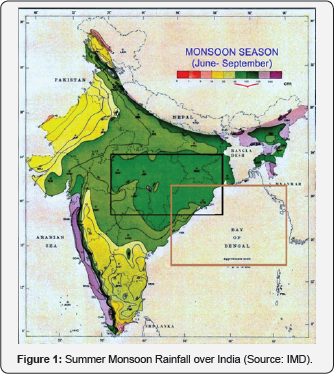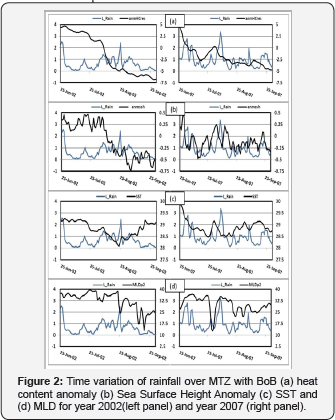Bay Of Bengal Upper Ocean and Monsoon Trough Region Interaction- Juniper Publishers
Juniper Publishers- Journal of Oceanography



Abstract
The confined to the study of northern Bay of Bengal (BoB) waters where the question of the presence and the maintenance of excess and deficit monsoon and its association with oceanic parameters to that Monsoon Trough Zone (MTZ) over India is being examined. The observed rain from IMD-NCMRWF is used to find out the correlation for deficit and excess years of rainfall over MTZ with BoB SST, SSS, MLD and OHC obtained from ECMWF ocean reanalysis. The study explains that the relation of the BoB oceanic parameters with the rainfall activity in the MTZ region has good correlation for the year 2007 than that of year 2002.
Keywords: Anomaly; Correlation; MLD; Excess and deficit rain; Heat content
Abbreviations: MLD: Mixed Layer Depth; OHC: Ocean Heat Content; SSS: Sea Surface Temperature; BoB: Bay of Bengal; MTZ: Monsoon Trough Zone
Short Communication
The monsoon is strongly coupled to the warm oceans surrounding the subcontinent. Most of the monsoon rainfall occurs in association with synoptic-scale systems, that is, the monsoon disturbances, which are generated over these waters and move onto the Indian landmass In particular, the Bay of Bengal (BoB) is exceptionally fertile, with a very high frequency of genesis of these systems. Thus the BoB plays an important role in the subseasonal variation of the monsoon. Several monsoon lows and depressions that contribute substantially to the summer monsoon rainfall of the Indian subcontinent form over the BoB and then move towards the land [1]. The formation of such weather systems depend on the convective activity over the BoB which is affected by conditions of the ocean underneath. Importance of atmosphere-ocean coupling in driving the dynamics of the northern BoB is well explained by Rao et al. [2]. The northern BoB during summer monsoon (June-September) is generally characterized by high SST, shallow surface layer of low salinity and weak wind compared to the Arabian Sea (Shenoi et al., 2002; Schott and McCreary, 2001). The weak winds cannot overturn the stratified low-salinity surface layer and hence results into a shallow surface mixed layer. Once the strong stratification in the surface layer takes place, the SST is mainly driven by surface net heat flux. As a consequence, though the Arabian Sea and BoB gets almost same amount of net radiative heating, the SST of northern BoB remains higher than 28 °C throughout the year, a condition favorable for generation of active convection [1]. Release of latent heat due to condensation maintains the atmospheric heating and sustains the monsoon circulation and associated rainfall over Indian subcontinent [3]. Altered atmospheric convection results in variations in air-sea heat flux, which can further influence the convection itself via SST changes.
The sea surface salinity also plays crucial role in the evolution of break conditions [4]. It is found that surface salinity in the northern BoB varies coherently with the rainfall over Ganga-Brahmaputra catchment area on intraseasonal time scale. Due to low salinity, precipitation over the BoB is greater than evaporation. The intraseasonal rainfall variation modulates the amount of river discharge, which in turn modulates the salinity over northern BoB on intraseasonal time scale. Since surface warming always follows the surface freshening, the time delay between the rainfall over catchment area and freshening at northern BoB helps in explaining the post monsoon warming. Apart from surface temperature, salinity and MLD the upper Ocean Heat Content (OHC) also plays a crucial role for the understanding of air-sea interaction processes and sea level variability over several climatic scales. There are few studies [5,6] which suggest the importance of upper OHC in the intensification of tropical cyclones. Recently, (Ali et al. 2015) [7] studied the existence and passage of the intraseasonal oscillation signals in the OHC of the upper BoB and its relationship to the air-sea fluxes. The objective of this study is to identify the role of oceanic parameters in the rainfall activity over MTZ during excess and deficit monsoon.
Data and Result Discussion
These above literature suggest that the atmosphere interacts not only with the sea surface temperature but also communicates with the thermal energy available in the upper layers of the oceans that involves various dynamical and thermodynamical processes. The present study the European Centre for Medium Range Weather Forecasts (ECMWF) ocean reanalysis data [8] and IMD-NCMRWF observed rain data from [9]are used. The India Meteorological Department - National Centre for Medium Range Weather Forecast (IMD-NCMRWF) India rainfall data is generated daily by merging rain gauge observations and satellite derived rainfall at 0.5° x0.5° grid. The ECMWF reanalysis at 0.25° horizontal resolution, with 75 vertical levels, forced by ERA-Interim atmospheric variables and covering the 1979-2013 time period, with NEMOVAR (3DVAR/FGAT) data assimilation of Temperature and Salinity profiles, Sea Level Anomalies, and satellite Sea Ice Concentration observations. Two different monsoon years have been selected i.e. deficit (2002) and excess (2007) monsoon years [10].

Figure 1 presents the average rainfall distribution from June to September (Source: IMD). The black box marked over land presents the rainfall zone where 50-150cm rainfall is observed. This area comes under the Monsoon Trough Zone, hence the rainfall analysis has been carried out over this region for the summer monsoon during two contrasting monsoon years 2002 (deficit) and year 2007 (excess). Since it is well known that BoB waters thermodynamics has close linking with the Indian monsoon variability, to know the correlation between BoB oceanic parameters and MTZ rainfall, area averaged parameters over the brown box area is extracted during June-September for the years 2002 and 2007. Monsoons are caused by the larger amplitude of the seasonal cycle of land temperature compared to that of nearby oceans. This differential warming happens because heat in the ocean is mixed vertically through a «mixed layer» that may be fifty meters deep, through the action of wind and buoyancy-generated turbulence, whereas the land surface conducts heat slowly, with the seasonal signal penetrating perhaps a meter or so. Hence the difference in the range for different oceanic parameters can be seen for excess and deficit years in the Figure 2. The time variation of rainfall over MTZ with anomaly in upper ocean heat content, anomaly in SSH, SST and MLD for year 2002 (left panel) and year 2007 (right panel) respectively is depicted in Figure 2. During year 2007 there was heavy rainfall event noticed over MTZ between 02-12 august. The clear relation of the oceanic parameters is noticed with this rainfall event. It suggests different time lag relation with different oceanic parameters.


Conclusion
The coefficient of correlation with the rainfall over MTZ is presented in Figure 3. It is noticed that oceanic parameters have better correlation during excess monsoon year 2007 compared to deficit year. However more detailed study is needed, covering longer period, to get the time-space lag correlation between MTZ rainfall and BoB oceanic parameters.
To Know More About Journal of Oceanography Journal Please Click on: https://juniperpublishers.com/ofoaj/index.php
To Know More About Open Access Journals Publishers Please Click on: Juniper Publishers
Comments
Post a Comment